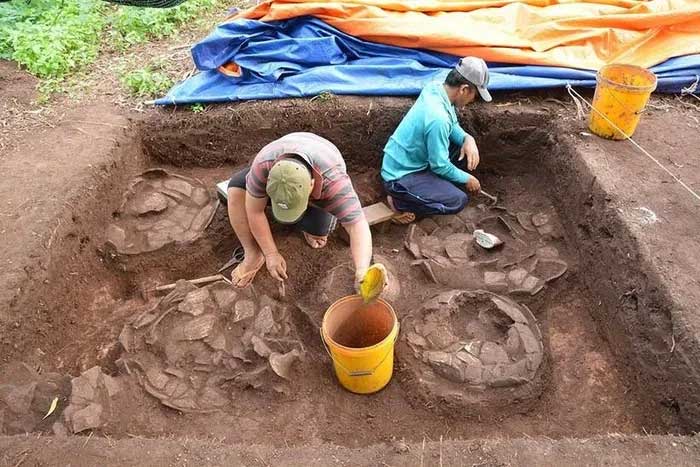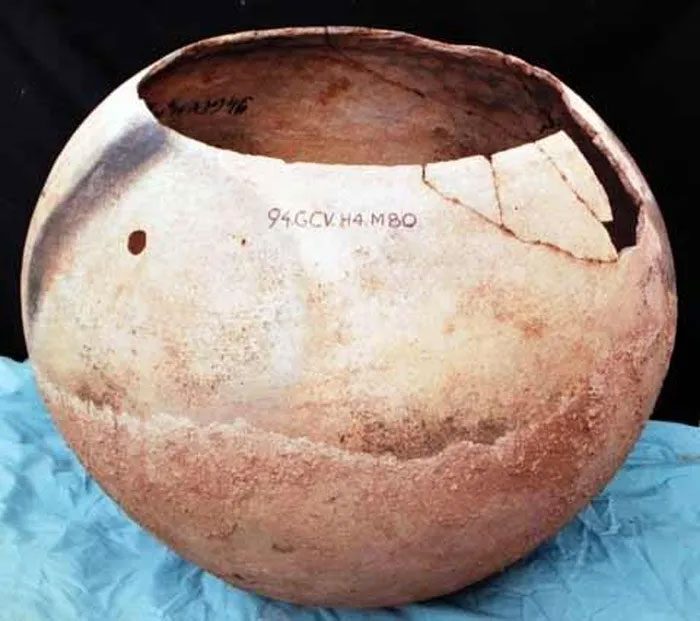On August 25, the Archaeological Institute announced the results of excavations at the national archaeological site of Giồng Cá Vồ.
Several significant discoveries were made, including the unveiling of a treasure from a burial jar, as reported by archaeologists from the Archaeological Institute and the Ho Chi Minh City Heritage Conservation Center.

185 burial jars and 13 earth graves uncovered during the excavation from 2021 – 2022. (Photo: Lương Chánh Tòng).
Prehistoric Burial Practices
Giồng Cá Vồ is an archaeological site located in Hòa Hiệp hamlet, Long Hòa commune (Cần Giờ – Ho Chi Minh City). The site is situated on a red soil mound, covering an area of approximately 7,000 square meters, rising about 1.5 meters above the ground, with the base of the mound frequently submerged in saltwater.
According to archaeological records, the site was discovered in December 1993, after which experts from the Ho Chi Minh City Museum of History and the Vietnam Museum of History conducted exploratory digs over an area of 230 square meters.
The cultural layer is up to 1.5 meters thick, consisting of four layers: agricultural soil up to 0.3 meters deep, basaltic red soil from 0.3 to 0.7 meters, black soil mixed with much pottery and ash from 0.7 to 0.9 meters, and yellow-red soil rich in pottery from 0.9 to 1.5 meters.
The results revealed 38 burial jars, of which 23 contained human remains. Additionally, experts discovered numerous grave goods made of ceramics, stone, glass, mollusk shells, iron, and jewelry.
In the subsequent excavation, archaeologists initially confirmed that this was a residence and pottery production site, serving as a burial ground for ancient people, with hundreds of burial jars and earth graves. Most of the remains in the jars were interred in a seated, fetal position. The burial jars consist of two types: ancient jars and earth graves – both of which have not been found in any other burial jar sites in Southeast Asia.
The abundance of jars, along with the consistency in burial methods and types, indicates that the burial practices of the Giồng Cá Vồ residents have been long-standing and stable, representing a unique tradition in the Southeast Asian region. Archaeologists have identified this as a burial site belonging to the prehistoric Sa Huỳnh culture, with the inhabitants clearly exhibiting Mongoloid characteristics.
Given the significance of these findings, in April 1994, the Ministry of Culture and Information issued a timely permit to protect the site from natural destruction and local agricultural activities. By 2000, the Ministry decided to recognize the Giồng Cá Vồ archaeological site as one of the archaeological sites that needed protection.
Internationally Significant Discoveries

Type 1 spherical burial jar with a round base.
“The Giồng Cá Vồ site needs to be preserved in situ at the excavation site and a display plan should be developed. Additionally, a dossier should be prepared to present to the Government for recognizing Giồng Cá Vồ as a special national relic,” said Associate Professor Dr. Tống Trung Tín – President of the Vietnam Archaeological Association.
In January 2021, the Archaeological Institute collaborated with relevant specialized units to conduct excavations. Experts from the University of Natural Sciences – Vietnam National University in Ho Chi Minh City utilized ground-penetrating radar to determine the potential and location of artifacts underground, covering an excavation area of 225 square meters.
The results revealed 185 burial jars, 13 earth graves, and hundreds of valuable artifacts made from various materials. Dr. Nguyễn Gia Đối – Acting Director of the Archaeological Institute – stated that this is an extremely important discovery, representing a significant success not only for Vietnamese archaeology but also with international implications.
Associate Professor Dr. Tống Trung Tín – President of the Vietnam Archaeological Association – noted that for the first time, archaeologists have discovered a site with a dense concentration of burial jars, with clear stratigraphic layers indicating a continuous development from habitation to burial practices.
In the central area of the Giồng Cá Vồ site, the stratigraphy is approximately 1.7 meters thick, divided into three phases: habitation, burial, and modern agriculture. The dating of the site is estimated to be around 2,500 years ago to the early Common Era.
Associate Professor Dr. Nguyễn Lân Cường – an anthropological expert – when researching the characteristics of the population through hundreds of remains from burial jars and earth graves, noted that these were groups of indigenous residents, primarily from the traditional Đồng Nai cultural community, who had cultural exchanges with the outside world, influenced by many aspects of island cultures.
Along with human remains, many artifacts such as animal-headed earrings, three-pointed earrings, gold leaves, gemstone bracelets, and conch shell objects were found at the Giồng Cá Vồ site. These discoveries help experts decode the history of the formation and development of the Ho Chi Minh City area over 2,000 years ago.
Previously, during two exploratory digs and the first archaeological excavation, experts found a relatively large number of artifacts, including: 21 animal-headed earrings, 2 three-pointed earrings, 1,046 stone beads, 9 bracelets, and many fragments of stone bracelets, over 200 beads, and 15 glass bracelets.
Some beads, 36 animal fangs, 8 bone tools, 70 spears, harpoons, hooks, and metal axes were also discovered. The pottery is very diverse, representing all types of ceramics from the Sa Huỳnh archaeological culture.
Archaeologists confirmed that there are 132 sites and locations in Ho Chi Minh City that have been classified as heritage sites, but only 160 ancient burial sites dating from the late 18th century to the early 20th century. Among these, 12 ancient graves meet the criteria for classification as heritage sites, and 21 graves are included in the conservation planning list. Two archaeological sites have been classified as national heritage sites: Giồng Cá Vồ and Hưng Lợi pottery kiln.
Although Giồng Cá Vồ has been recognized as a national archaeological site since 2000, the land has yet to be cleared. Therefore, the archaeological community advocates for the prompt clearance of the land to preserve and promote the value of the site.




















































